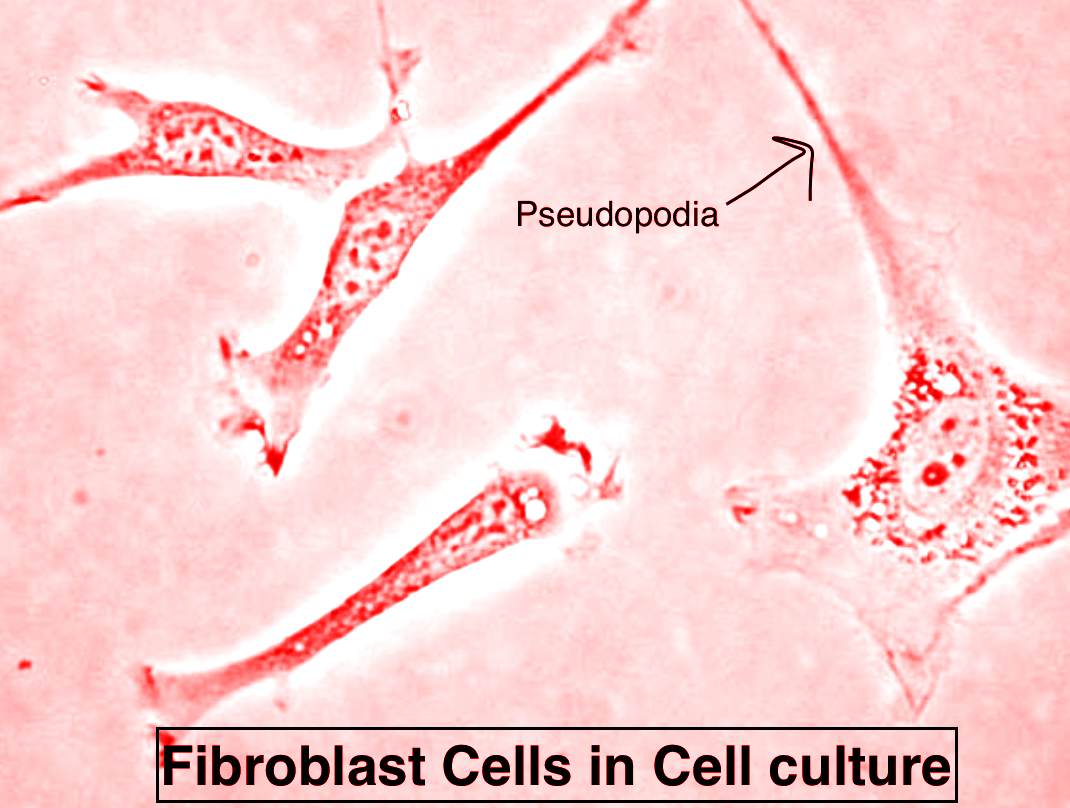
Pseudopodia are produced by
(a) Plasma cell
(b) Mast cell
(c) Adipose cell
(d) Fibroblast cell
Answer
561.9k+ views
Hint: Pseudopodia are long membrane extensions produced by a type of cell which is long and spindle- shaped. It is one of the common types of connective tissue and it secretes a protein that is the most abundant protein in the animal world.
Complete answer:
Pseudopodia is a type of locomotory apparatus that is usually observed in the protozoans belonging to the group of Sarcodina or Rhizopoda. These are temporary membranous extensions of the cell membrane for locomotion or for the ingestion of food. The fibroblast cells along with the help of microtubules and microfilaments in the cytoplasm produce these cytoplasmic extensions. A fibroblast cell is a large, spindle-shaped cell, and a part of connective tissue. It secrets collagen which forms the bulk of the extracellular matrix in any tissue. Fibroblast cells are also involved in tissue repair and maintenance.

So, the correct answer is ‘Fibroblast cell.’
Additional Information:
- A mast cell is a type of white blood cell. Their cytoplasm is filled with minute granules containing histamine. They, along with basophils, play a major role in the regulation of allergic responses.
- Adipose cells are single membrane- bound fat- containing cells. It is a type of connective tissue that is specialized in the synthesis and storage of fat globules.
- Plasma cells are sub-species of B-lymphocytes, which in turn, are a type of leukocytes or WBCs responsible for the production of antibodies against a foreign antigen.
- Microtubules and microfilaments are cytoskeletal apparatus that deals with the maintenance of the structural framework of a cell while also helping the cell organelles to suspend in the cytoplasm.
Note:
- Protozoan protists are classified into four groups based on the type of locomotion exhibited by its members: Mastigophora, Sarcodina, Sporozoan, and Ciliates.
- Mastigophora possesses flagella as their locomotory apparatus. Sarcodina locomotion by pseudopodia. Sporozoans are non- motile and Ciliates bear numerous minute projections called cilia as their locomotion apparatus.
Complete answer:
Pseudopodia is a type of locomotory apparatus that is usually observed in the protozoans belonging to the group of Sarcodina or Rhizopoda. These are temporary membranous extensions of the cell membrane for locomotion or for the ingestion of food. The fibroblast cells along with the help of microtubules and microfilaments in the cytoplasm produce these cytoplasmic extensions. A fibroblast cell is a large, spindle-shaped cell, and a part of connective tissue. It secrets collagen which forms the bulk of the extracellular matrix in any tissue. Fibroblast cells are also involved in tissue repair and maintenance.

So, the correct answer is ‘Fibroblast cell.’
Additional Information:
- A mast cell is a type of white blood cell. Their cytoplasm is filled with minute granules containing histamine. They, along with basophils, play a major role in the regulation of allergic responses.
- Adipose cells are single membrane- bound fat- containing cells. It is a type of connective tissue that is specialized in the synthesis and storage of fat globules.
- Plasma cells are sub-species of B-lymphocytes, which in turn, are a type of leukocytes or WBCs responsible for the production of antibodies against a foreign antigen.
- Microtubules and microfilaments are cytoskeletal apparatus that deals with the maintenance of the structural framework of a cell while also helping the cell organelles to suspend in the cytoplasm.
Note:
- Protozoan protists are classified into four groups based on the type of locomotion exhibited by its members: Mastigophora, Sarcodina, Sporozoan, and Ciliates.
- Mastigophora possesses flagella as their locomotory apparatus. Sarcodina locomotion by pseudopodia. Sporozoans are non- motile and Ciliates bear numerous minute projections called cilia as their locomotion apparatus.
Recently Updated Pages
Master Class 12 Business Studies: Engaging Questions & Answers for Success

Master Class 12 Economics: Engaging Questions & Answers for Success

Master Class 12 English: Engaging Questions & Answers for Success

Master Class 12 Maths: Engaging Questions & Answers for Success

Master Class 12 Social Science: Engaging Questions & Answers for Success

Master Class 12 Chemistry: Engaging Questions & Answers for Success

Trending doubts
What is meant by exothermic and endothermic reactions class 11 chemistry CBSE

Which animal has three hearts class 11 biology CBSE

10 examples of friction in our daily life

One Metric ton is equal to kg A 10000 B 1000 C 100 class 11 physics CBSE

1 Quintal is equal to a 110 kg b 10 kg c 100kg d 1000 class 11 physics CBSE

Difference Between Prokaryotic Cells and Eukaryotic Cells




